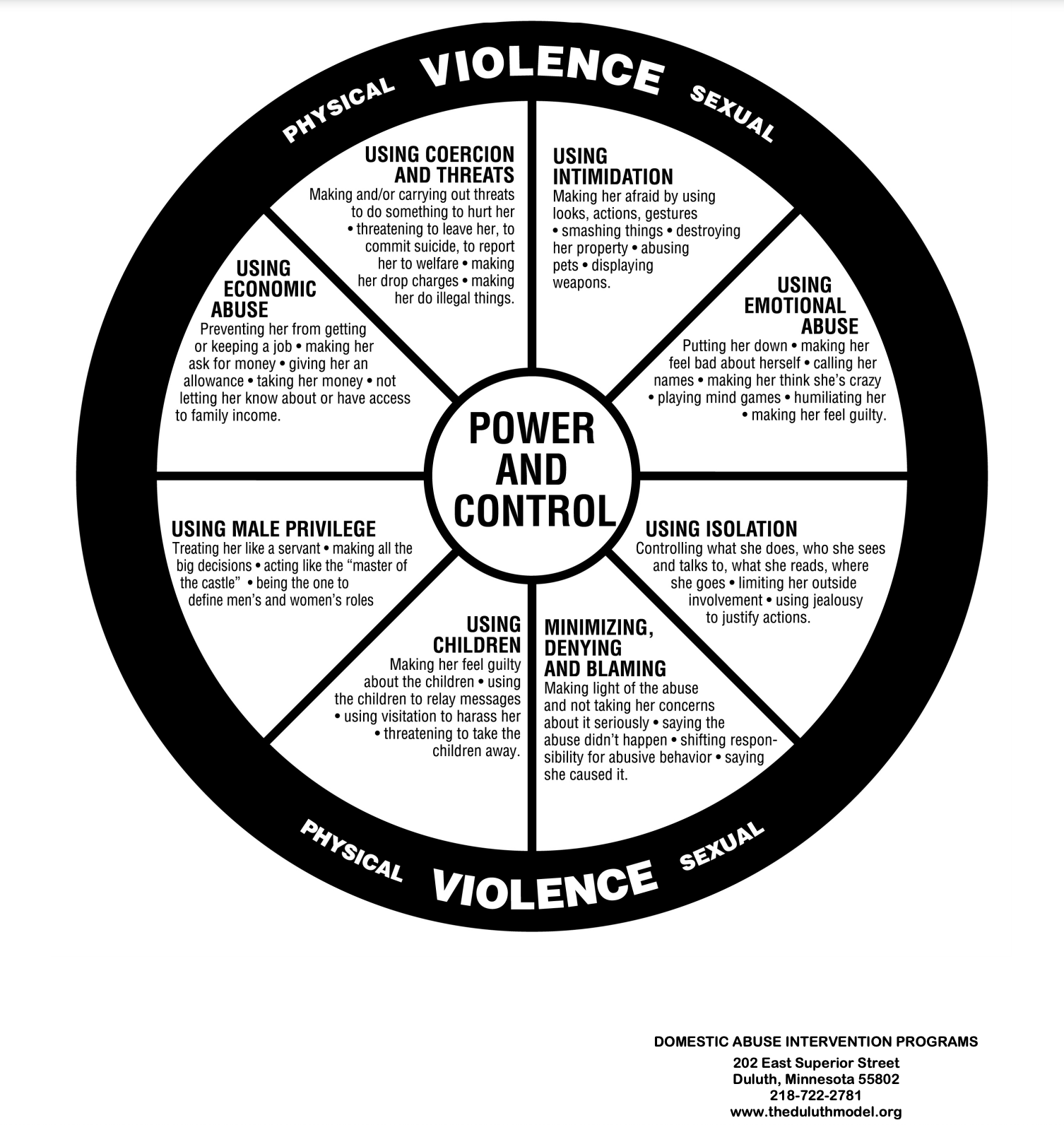The Power and Control Wheel image is a helpful tool that therapists, first responders, faith-based organizations, family and friends can use to help uncover when abuse is present. It paints a picture of the most common ways overt and covert abuse manifest through Intimate Partner Violence. If you ever interface with victims of abuse, understanding the way the wheel works is an important part of becoming equipped. If you are being harmed by abuse, seeing and understanding the Power and Control Wheel often brings that “a-ha” realization to identify the abuse that is happening to you.
Several different organizations and foundations have created their own version of the Power and Control Wheel, but in this blog we are using the wheel created by the Domestic Abuse Intervention Programs. Although the examples in this particular Power and Control Wheel focus on male abuse against women, overt and covert abuse can be wielded by anyone in any relationship, and there are different examples of the wheel available that demonstrate how it can manifest differently for other genders or groups of people. (See relevant resources below.)
The forms of abuse laid out within the wheel reveal different ways abusers try to dismantle their victims and keep things out of balance. In a healthy relationship, couples compromise through authentic and vulnerable conversations, where each individual feels safe asserting their thoughts and feelings. If anyone or multiple elements of the Power and Control Wheel are being used by one of the partners, they are taking an abusive, dominant stance instead of a loving, respectful attitude. Even just one abusive tactic shown in the wheel that is repeated throughout a relationship is enough to define an abusive relationship.

It’s critical to note that while the wheel shown above focuses on more obvious and extreme abuses, such as threatening to hurt her, keeping her away from her friends, playing mind games, etc., some of these tactics can be much more subtle. These seemingly subtle forms of covert abuse expressions should not be dismissed or considered less harmful than overt abuse: Covert Emotional Abuse can be equally devastating to the victim, leading to severe physical and psychological distress.
For instance, the “using emotional abuse” section of the wheel mentions put-downs and name-calling as forms of abuse. These can be administered in a covert way that not all observers and responders may immediately think of as abuse. A husband calling his wife the “B” word is clearly wrong, but it is also wrong for someone to name call or put down their spouse by focusing on their insecurities, expression of emotions, or by making fun of their appearance. Picking on something that is sensitive for the spouse like calling them “thunder thighs,” “horse face,” or any other nickname that is not aimed to endear and is not uplifting, when done over and over is extremely emotionally abusive. Its effect is compounded when done in front of others.
Covert manifestations of power and control like these can be even more harmful because they are less likely to be recognized as abusive by the victim and even outsiders which means the abuse could carry on undetected for a long time. Each of the sections of the wheel containing examples of overt abuse can also show up in more subtle ways, which is an important distinction to make, especially when working with, helping or ministering to individuals who may be in an abusive relationship and not know it.
For responders, which qualifies as anyone who has the opportunity to interact with an abuse victim, understanding the Power and Control wheel and being able to present it to victims in the right contexts can bring clarity to their situation. Many victims are unaware that the harm they are experiencing is abusive, so empowering them by giving it a name as well as providing examples and correct vocabulary may be the first necessary step to clarifying their situation and leading them into a journey of healing.
To learn more about how the Power and Control Wheel can be used to help explain abuse to responders and victims, visit the following page to learn more about our complete training and curriculum that is ideal for organizations, foundations, schools and faith-based organizations: https://themendproject.com/i-want-to-help-someone-being-abused/gain-tools-to-respond-to-abuse/
Resources
This power and control wheel highlights various power and control dynamics within abusive partnerships in the LGBTQ+ population: http://www.ncdsv.org/images/TCFV_glbt_wheel.pdf
The Teen Power and Control Wheel: http://www.ncdsv.org/images/Teen%20P&C%20wheel%20NO%20SHADING.pdf
Power and Control Wheel related to Child Abuse: http://www.ncdsv.org/images/CD_PowerControlWheelNotValuingChildren.pdf
The M3ND Project is a 501(c)(3) nonprofit organization dedicated to educating, equipping and restoring all those impacted by abuse. We educate on original abuse and Double Abuse®, and train first responders on how to respond to individuals effected by abuse in a trauma-informed and compassionate manner. Please partner with us in this important work through your donations. CLICK HERE.







